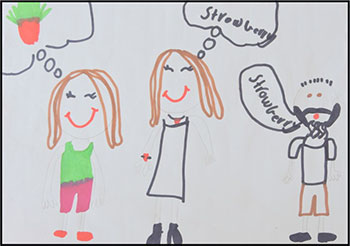A Visual - Spatial way of thinking...
Around 10 to 20 % of the population tend to think in pictures rather than words.
Makenzie, a 10 year old who did the program in in 2014, said...
‘I’m not a CD; I’m a DVD”

Makenzie illustrated the difference
between word and picture thinkers.
This statement summarises clearly the difference between the thinking styles of most people (word thinkers) and the minority (picture thinkers). Most teachers are word thinkers (auditory sequential) and teach they way they learnt, a learning style often difficult for picture (visual spatial) thinkers.
Picture thinkers have creative skills which enable them to become artists, musicians, architects, entrepreneurs, sportspeople, designers... they see the whole picture rather than the segmented detail.
Makenzie did her program in January 2015 and is obviously very pleased with her progress and own sense of worth. This video clip arrived from Makenzie in May, 2016.
Visual spatial thinkers:
- can utilise their brain’s ability to alter and create perceptions (primary ability);
- are highly aware of the environment;
- are more curious than average;
- think mainly in pictures instead of words;
- are highly intuitive and insightful;
- think and perceive multi-dimensionally (using all their senses);
- can experience thought as reality;
- have vivid imaginations.

Many of the world’s most famous and talented people - Leonardo da Vinci, Albert Einstein, Kerry Stokes, Kerry Packer, Richard Branson, Walt Disney, Cher, Jamie Oliver, Hans Christian Anderson, Roald Dahl, Henry Ford, Whoopie Goldberg, John F. Kennedy, to name a few - have one thing in common: they are all dyslexic.
These beautiful people experienced failure at school; not because there was something wrong with them (often that’s what they were told) but because the teaching style did not suit their learning style.


